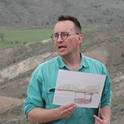Article
High-Magnesian Andesite from Mount Shasta: A product of Magma Mixing and Contamination, not a Primitive Mantle Melt
Geology
(2007)
Abstract
It has been proposed that high-Mg andesites (HMAs) from the Mount Shasta area may represent near-primary mantle melts, carrying signatures of slab melt interaction with the Cascadia mantle wedge. We present strong evidence that their formation involved mixing of dacitic and basaltic magmas and entrainment of ultramafic crystal material, and thus they cannot represent primitive magmas. The rocks contain (1) low-Mg# (65–72) clinopyroxene (cpx) and orthopyroxene (opx) phenocryst cores containing dacitic melt inclusions, and (2) high-Mg# opx and olivine xenocrysts, all of which are rimmed by euhedral overgrowths of cpx or opx similar in Mg# (87) to skeletal olivine phenocrysts. Textural relations indicate that ultramafic xenocrysts reacted with dacitic liquid, after which the contaminated magma mixed with basaltic liquid to produce a hybrid HMA bulk composition. High Mg, Cr, and Ni derive from the latter inputs, whereas high Sr/Y and overall adakite affinity is inherited from the dacite end member, which is arguably crustal in origin. We suggest that open system processes may be more important in the petrogenesis of HMAs than generally recognized, and that their magnesian compositions do not necessarily imply that they are primitive mantle melts.
Keywords
- High-magnesian andesite,
- Primitive magnesian andesite,
- Mount Shasta
Disciplines
- Geology and
- Volcanology
Publication Date
April, 2007
Citation Information
Martin J. Streck, William P. Leeman and John Chesley. "High-Magnesian Andesite from Mount Shasta: A product of Magma Mixing and Contamination, not a Primitive Mantle Melt" Geology Vol. 35 Iss. 4 (2007) Available at: http://works.bepress.com/martin_streck/8/
